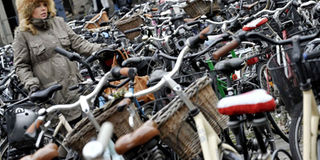Taming my bicycle and ‘eating plains’ in the City of Bikes

In the City of Bikes is Jordan’s story of how he came to the Netherlands in 2002 to study how American cities back home could learn from the Dutch how make their own urban spaces more bicycle-friendly to ease traffic congestion. In a carefully woven plot, the author relates how he fell in love with biking in a city that loves bicycles. PHOTO | FILE
What you need to know:
- Everywhere I went I was enthralled by how cycling is not just a subculture or fashion statement but literally the way to do things here. Urban anthropologist Prof Eileen Moyer told me that biking for the Dutch is literally like the human act of breathing in and out, or simply put, “walking without looking at your feet.”
- For anyone who grew up in rural Kenya in the 1960s, through the 80s, the bicycle harbours nuggets of nostalgia. That exhilarating moment when one learnt how to balance and ride on two wheels remains unforgettably etched in our memories forever.
In the collection of essays, What is Man? and Other Essays, American author and humourist Mark Twain wrote one of his most hilarious essays titled “Taming a bicycle’’. In it we encounter vintage Twain as he recounts in amusing fashion his personal experiences of learning how to ride a bicycle. From referring to his bike as not “fully-grown” but a mere “colt” that is skittish, he compares his difficulties in learning how to ride a bicycle to learning how to mount a horse.
In his typical humour he narrates how he fell and crashed several times while dismounting the now antiquated high-wheel bicycle even though he had enlisted the services of an expert to teach him. Eight days later, and with a hospitalisation in between, he triumphantly declared, “I can steer as well as I want to, now…” However, he has a warning to would-be bicycle learners then and even now, “Get a bicycle. You will not regret it if you live.”
The story of Mark Twain has literally been my story in Amsterdam lately, albeit with minor variants. The moment I landed in Amsterdam, I was immediately taken in by the sheer seamless and effortless ways in which the Dutch were beholden to their bicycles.
Everywhere I went I was enthralled by how cycling is not just a subculture or fashion statement but literally the way to do things here. Urban anthropologist Prof Eileen Moyer told me that biking for the Dutch is literally like the human act of breathing in and out, or simply put, “walking without looking at your feet.” And so in the queer ways for which I have been known lately, I set out to “tame this bicycle thingy!”
BEAUTIFUL VILLAGE DAMSEL
To begin with, I bought myself two things; a second-hand Gazelle bicycle just to get myself into the Amsterdam swagger and a copy of Pete Jordan’s In the City of Bikes: The Story of the Amsterdam Cyclist which I initially thought was one of those what-to-do texts that one has to read to understand cycling in Amsterdam.
As an avid reader of things cultural, Jordan’s book turned out to be more than what I had bargained for. Framed as part memoir, part historiography but in many ways a narrative tour of the street style in Amsterdam. In the City of Bikes is Jordan’s story of how he came to the Netherlands in 2002 to study how American cities back home could learn from the Dutch how make their own urban spaces more bicycle-friendly to ease traffic congestion. In a carefully woven plot, the author relates how he fell in love with biking in a city that loves bicycles and was later joined by his wife, Amy Joy, who has since discovered her own passion as a bicycle mechanic.
For those historically inclined, Jordan’s book retells the beginnings and evolution of Dutch cycling as part of the upper class pastime in many European cultures in the 1890s up until the fashionable craze of biking in the 1920s, and more significantly, the role of bicycles in Amsterdam city’s resistance to Nazi occupation in the Second World War. As a precaution, Jordan also spares a moment to warn anyone new in the city of bikes to beware of what the Dutch call zwijntjesjagers – or simply bicycle thieves. Yet in so many ways Jordan’s memoir and Twain’s essay appear to speak to a lot of Kenyan audiences.
For anyone who grew up in rural Kenya in the 1960s, through the 80s, the bicycle harbours nuggets of nostalgia. That exhilarating moment when one learnt how to balance and ride on two wheels remains unforgettably etched in our memories forever. As teenagers seeking validation of our young male egos, knowing how to ride a bicycle was the first step in becoming men and doing something for ourselves.
In my heyday, getting the eye of a beautiful village damsel required one to perform crazy antics on a bicycle just to get noticed. Much like Odili Samalu in Achebe’s classic A Man of the People, I remember as teenagers how we all loved ‘to eat the hills’ and fly through the valleys on bicycles much to the glee of our cheering siblings.
Fast forward to 2016 and I am literally reliving my childhood memories. Like Twain, I have gotten a bike and I don’t regret it. I relish every moment as I ‘eat away the plains’ in the City of Bikes, pedaling and ‘taming my Gazelle’ each morning across the Amstel River!





